Don't Tell Italy, But We Might Like Istria Better
 Hanging out in at Cape Kamenjak in Premantura park. All photos by Pavia Rosati.
Hanging out in at Cape Kamenjak in Premantura park. All photos by Pavia Rosati.
When Fathom founder Pavia Rosati went to Istria in Croatia in early summer, she liked what she saw: charming old hill towns, rocky coves for swimming, lovely people, tranquil landscapes, incredible food. This place won't stay a secret for long.
ISTRIA, Croatia – Italy had better not go to Croatia, because it's going to get jealous. Especially along the Adriatic Coast in Istria. This is what Italy should be.
And, yes, for much of history Istria was a part of Italy, but what a difference a World War II annexation and the former Yugoslavia have made. The Italians are going to revoke my passport for saying this, but Istria is altogether cleaner, quieter, less touristy, cheaper, and prettier than Italy. And green. So, so green. Rolling hills, vineyards, a lone cypress standing on a ridge. Palm trees sharing the landscape with olive groves and pines. You look to land from sea and see a vast expanse of forest punctuated with terracotta villages and proud church steeples.
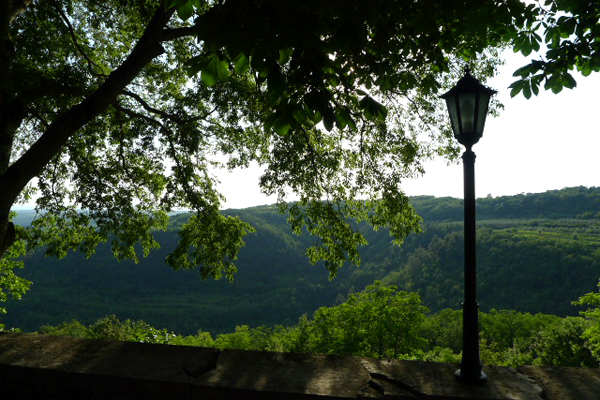
This is the view you see everywhere.
PLAN OF ATTACK
I spent a week in Istria, the small peninsula a few hours' drive from Venice in early summer last year, working my way from the northern range to the southern tip, eating prosciutto, cheese, and seafood; tasting olive oil; drinking lots of wine; watching dogs nuzzle for truffles; chatting up guys in my Venetian-inflected Italian. I loved everything about this place.
Town names throughout the region appear in Croatian and Italian. Triban/Tribano. Novigrad/Cittanova. Motovun/Montona. Everyone speaks Italian, but what Croatians can do with accent marks — so many accent marks on Cs and Zs, and Ss — is remarkable.
And though the Italian influence is strong, historically speaking, modern Italy is but a speck in the timeline of Istria, a land that's seen more than its share of action and invasions. The Illyrians settled in the Bronze Age, followed by the Romans, then the Byzantines, the Croats, the Slovenes, the Franks, the Venetians — and this overview only takes us up to the late 1700s. That's a lot of people for a lot of land, but no one has ever been able to reisist the appeal of hill towns, forests, and beaches within an hour's easy drive.
As a holiday destination, Istria is right for everyone. Great for families: camping and biking and picnicing. Great for lovers: long lunches in the sunshine, cruising islands on a sailboat. Great for single travelers: rent a car and hit the open road. Great for groups of friends: rent a villa and take over the back room of a konoba ("tavern") for wine-soaked dinners that last until dawn.

A typical street in Grožnjan.
START NORTH IN THE HILL TOWNS
Charming historical fact: The towns whose names end in "-an" and "-ana" were founded by former soldiers of the Roman Empire, who were promised land in exchange for service. You'll see Roman touches throughout the quiet and sleepy towns — from the architectural arches to the paintings of lions in coliseums in old churches.
Grožnjan has some 200 inhabitants, cobblestone streets, great views of the valley, and a charming church, Sts. Vitus, Modestus, and Crescentia, where I watched an elderly couple renew their wedding vows in front of their multi-generational family on a sleepy Thursday afternoon. Music is very big in Grožnjan, especially in summer months during the jazz festival.
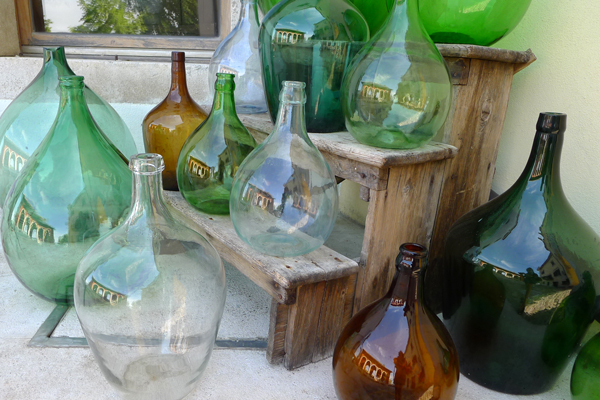

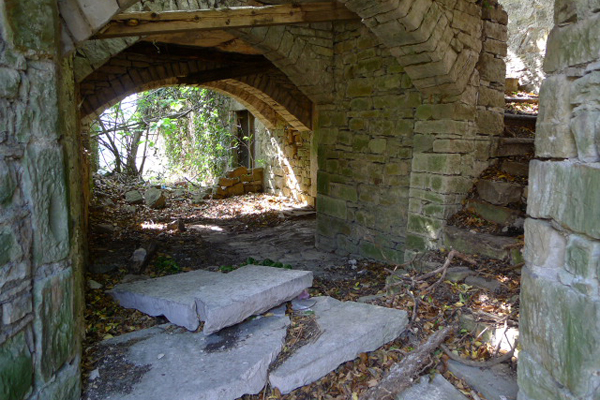
In and around Opratalj, the Grimm-like town.
Only 100 people live in Oprtalj, a fortified town with great views of the Mirna ("Quiet") Valley. I was really taken by this town — its abandoned houses, overgrown vines, decrepit buildings, dark corners inviting mischief. It's a Grimm's fairy tale come to life. I saw lots of signs for villas to rent. Note to self: next time.
Everybody loves Motovun, birthplace of racecar driver Mario Andretti, but I found it a little touristy. Too many truffle shops; too many "Anthony Bourdain stopped here" signs. Hotel Kaštel is a boutique hotel with lots of outdoor space and baroque rooms with bas-relief sculptures on the walls.
Nearby Buzet is more my speed, with medieval arched portals and gates, bell towers, wells, and an annual September truffle celebration, which the good people kick off by scrambling an omelette using 2,000 eggs and ten kilos of truffles. What's not to love? Stay a night: Vela Vrata is a cozy boutique hotel that makes for a nice base in the area.
While I was in northern Istria, I stayed at San Rocco in Brtonigla (I tried for three days but never did learn how to pronounce the town name), a small and elegant family-run hotel with swimming pool overlooking the valley and an exceptional restaurant. San Rocco is regularly voted Croatia's best boutique hotel for good reason. The Fernetich family are charming hosts. The young son is especially adorable.

Inside the Ipša operation.

Irene and Klaudio Ipša.
ALL HAIL THE OLIVE
One day, we drive on a narrow hilltop road along a ridge through the valley between Livade and Ipsi, precipitous drops on either side, the sun beating down, olive groves and forests spreading out to infinity.
Why am I in a covered car? Where's my convertible?
Our destination was Ipša, the boutique olive oil farm run by Klaudio Ipša and his wife Irene. They took over the family property in the 1990s, a time when none of the cousins were interested in the farming life, those dark ages not long ago before people became obsessed with slow food and artisanal everything. They restored every olive tree they could, which took some doing, though it turns out olive trees are a hearty bunch. "An olive tree is like a mother," Klaudio explained. "You can never lose her, even if you ignore her." As opposed to that other ancient Mediterranean staple, the grape vine, which requires considerably more maintenance. "A grape vine," he continued, "is like a wife. If you ignore her, well, it all goes to ruin."
The Ipšas grow five different olives — three indigenous to Istria, two imported from Italy — and produce four oils, ranging in flavors from mild to strong. This is a truly artisanal operation: The olives are pressed within four hours of being picked at the frantoio 20 kilometers away. The project is a labor of love, but their labors are paying off: Ipša regularly wins prizes and international recognition for their oils.

Klaudio demonstrates the art of the olive oil tasting.
Klaudio gives us a lesson in tasting olive oil:
1. Pour: Drizzle oil into a small cup.
2. Warm: Place the cup in your palm and, covering the top with the other hand, gently roll it around, letting the warmth of your hands warm the olive oil. This helps release the fruit flavors.
3. Smell: You're getting notes of fruit, leaf, grass.
4. Taste: Take a small sip to coat the mouth, inhale quickly two times, slurping the oil around your mouth (you've seen wine people do this), then swallow.
5. Look: Just don't be fooled by the pretty green tones. Color in olive oil has no impact on taste.
Irene prepares a quick and gorgeous lunch of sautéed pork, vegetables, cheeses, and salumi, and we eat in the picture-perfect rustic cantina on picnic tables. This is just supposed to be a quick snack, but it's hard to stop at a few bites. Ipša is open to visitors year-round.


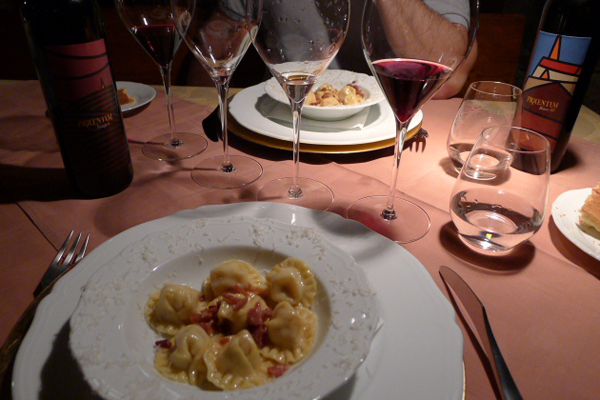
Lunch at Toklarija in the middle of glorious nowhere.
The real lunch was at Toklarija (Sovinjsko Polje 11; +385-52-663-031), a slow food restaurant in a converted olive mill in the middle of nowhere between Motovun and Buzet. The setting is very atmospheric, dark, and brooding, more befitting a winter's night than a glorious June afternoon. I loved the room — the stone walls, the cauldrons, the fireplaces — but I might have preferred sitting under the trees outside. The meal itself was a reverential experience; chef Nevio Sirotić is not one for chit-chat. There's no menu: You eat what he serves you. First course was goat cheese with capers, dandelion, forest mushrooms, and powdered rosemary. Second course, minestra, a soup made with beans, pasta, meat, and potatoes. Third course: ravioli filled with prosciutto and grana padana. My father and all my uncles would say that it's sacrilege to have soup and pasta in the same meal, but this was heaven. The main course was a Venetian recipe from the 1600s that involved goat, potatoes, and herbs. Dessert was a slice of chocolate cake with preserved cherries.
Our wines came courtesy of Dimitri Brečević, the French (mother) and Croatian (father) winemaker behind Piquentum wines. They make their white wine in the style of red wine, and I gave it high marks.

Dinner at Marina is beautiful and delicious.

Marina Gaši and her husband, Davor Buršić.
Marina Gaši, the chef at Marina (Sv. Antona 38; +385-99-8121-267) in Novigrad, a modernish beach town with lots of hotels and sailboats, was much more charming. One of the hotter places in town, Marina is notable for chef Marina (female chefs are a rarity in Croatia, too), who recently renovated her family's restaurant by focusing local and fresh ingredients, with an emphasis on seafood. "We don't even have a freezer," Marina told me.
The dinner she served was delicious: sesame-crusted sardines with zucchini carpaccio; raw sole on a bed of black risotto with merlot salt; pljukanci pasta with squid ink, scallops, and wild asparagus; chocolate tart with lemon oil and salt. Asked what her mother thinks of her daughter's innovative cuisine, Marina says, "She washes the dishes." Ah, Slavs. So understated.
BEHOLD! THE TRUFFLE!
The Motovun Forest in the Mirna Valley is the #3 truffle region in the world after Alba and Piedmont. The first truffle was discovered in 1929, and today there are 1,500 truffle licenses for hunters. That's for the men, not for the dogs who do the actual work. I watched two master truffle hounds, Jacky and Duna, in action. Within fifteen minutes of entering the forest, they had barked their haul: three palm-sized truffles. I stared as the dogs moved out of the way to let their handler, Ivica Kalcic, unearth the truffles with a trowel and declare that the booty would earn about $30 per truffle. The dogs found the loot with such efficiency that it was hard to believe the show wasn't staged. But Kalcic, a small man in olive green pants, a green T-shirt that barely contained his amazing belly, and camouflage straw hat, looks like a guy who can't be bothered to lie to skeptical Americans.


Ivica Kalcic is a man who looks like he's seen better truffles.
Zigante in Livade is the fancy truffle restaurant that clearly rules the roost in the valley. In 1999, Giancarlo Zigante found and served the largest truffle in the world, which weighed 1,310 grams. The restaurant displays its Guinness World Record plaque with pride. Zigante is the kind of restaurant that's happy to shave truffles on top of your truffles. And your ice cream.
BE ONE WITH NATURE. BE NAKED.
Here's what I did not do, but I wish I had: bike, paraglide, balloon, cave, and pitch a tent and camp on the coastline. I am, at most, a casual bike rider, but the hills look gentle and are so picturesque. The tourist board is organized for it, too: I saw bike maps everywhere. Istria-Bike.com is a great online resource for trails, agencies, and tours. The 78-kilometer route along the abandoned and mythic Paranzana train route looks especially fun. I paraglided once in Aspen, which makes me by no means an expert, but I know enough to say that the valleys are just screaming for a jump. But there's action underground, too: Mramornica Cave in Brtonigla is a fine specimen for caving. Gral Putovanja in Buzet can arrange hot air balloon trips, as well as fresco workshops for those who would rather keep their feet on the ground. As for camping, well, it typically ranks 45,575th in things I ever want to do, but one look at the shoreline at Camp Colone outside Bale, and I was filled with envy for the people who had the privilege of waking up in the small tent along the calm sea.
Those campers probably had a sunset skinny-dip in private. Everyone else in Croatia is happy to bare all for everyone to see. Or so it would seem. What's with all the nudist colonies in Croatia? I like being naked as much as the next girl, but I didn't really want to find out about the nude camps. (The non-airbrushed family photos in the Valalta Naturist Camp brochure are enough for me. Click on the 1978 photos at your own risk.) But it was impossible not to notice all the FKK signs along the road. "FKK" is the innuendo-heavy acronym for Freikörperkultur, the German Free Body Culture movement. So maybe it's the Croats or maybe it's the visiting Germans who are taking it all off and jumping in the sea. But let's just leave it at that, shall we?

Couples — those human, those stone — canoodle in Vrsar.

Daniela and Tomaslav Masla at L'Angelique Cafe in Vrsar.
TO THE SEASIDE
The above paragraph might not put you in the beachy mood, but that's too bad. The Croatian coast really is extraordinary. Vrsar was another favorite hill town, filled with pastel houses overlooking the marina, eighteen islands dotting the harbour, sailboats gliding by. Casanova came here in the mid 1700s for the food and the women, and in his honor the city hosts Casanovafest, the "love and erotic festival" every June, which culminates (so to speak) in a four-minute kissing competition. Vista Hotel in Old Town is an attractive, 30-room hotel, a former factory worker's retreat now filled with olive trees and lavender. It's a great place for bottomless cups of coffee and a good novel. L'Angelique Café is the sweet coffeeshop at the base of St. Martin's church run by siblings Daniela and Tomaslav Maslac. The cakes are made by Marina, their mother.
As for all the sculptures dotting the small town, blame or credit The Montraker School of Sculpting and the abandoned quarry of the same name that provides the stone for students and artists to work. It's become a tradition for the artists' to leave their sculptures behind, around the marina, in town, on the beaches, at the bus stops.
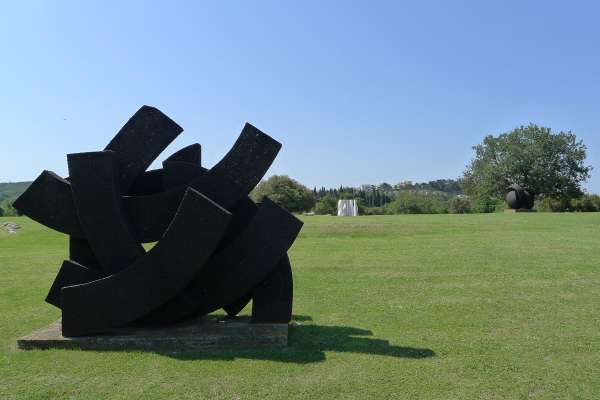

Dušan Džamonja Sculpture Park
More serious sculpture awaits outside Vrsar at Dušan Džamonja's Sculpture Park. For such monolithic works of iron, granite, marble, and welded nails, this place is pretty Zen.
Rovinj, everybody told me, is the jewel of Istria. They're right. But that's a separate story. I barely had time for a quick dip in my balcony pool at the funky-cool Hotel Lone when it was time to leave for Bale.
Our destination for drinks was Kamene Priče, a jazz club, tavern, and gathering place run by Tomislav Pavleka, a former photographer from Zagreb and Bosnia who spent sixteen years living in Amsterdam and is a bit of an anti-everything bohemian. The decor at the bar is simple and understated — bookshelves, sofas, a sweet pergola outside. "We don't allow bankers," Tomo tells me, "Bankers are evil." What about lawyers, I ask. "They're okay. Not as bad." And doctors? "Depends," he says. "For dogs."
Some 3,600 years ago, Bale was a Celtic settlement. The town had been abandoned for a long time, but it's rebounding with a lot of funky energy and an artsy scene. Tomo drove us 15 minutes away towards Camp Colone, to a field where very old-looking stones are arranged in circles. You stand at the center and talk, and the effect is a haunting echo chamber. It's all very occult, and no one can explain it. (Or maybe Tomo just didn't want to.) A local mayor built himself a home here and has claimed it as private property, but it's worth finding Tomo and asking him to sneak you in.
Afterwards, we drove into Camp Colone and watched the sun set over the Adriatic. That's where I suddenly wished I was spending the night in a tent. Tomo plucked sea grass from the rocks on the shore and handed it to me. "Motar," he said. "Eat it. It's an aphrodisiac." It wasn't an aphrodisiac, but it was delicious.
The new hotel in Bale, Hotel La Grisa, was built from seven old homes. As long as they kept the external walls, they could do whatever they wanted inside. The decor is minimalist, with lovely textiles on the sofas and armchairs and artwork made from found objects: horseshoes, old money, laminated promissory notes. None of the rooms costs more than 100 euros, even in high season. The restaurant at La Grisa is sophisticated and nuanced. Chef Nikola Vuković served a really impressive meal: shrimp with ricotta and orange blossom pesto; risotto with wild asparagus, black truffle, and an egg yolk in the center that you're meant to break and stir into a creamy dream; Boscarin (an Istrian oxen) ribs served with a puree of green beans. For dessert (yes, I ate dessert after all that), gnoc, a potato cake served wtih fig jam, and fritola, a fried cake with grapes, nuts, and mistletoe rakia (shnapps). Incredible.
My host for dinner was Duilio Belić, who presented his range of nine exquisite Oleum Viride olive oils for tasting. And so I learned even more about olive oil. That apples are the best thing for cleaning the palate between tastings, and that "since olives are fruit, extra virgin olive oil is essentially fruit juice." I'm not sure about that, but I am sure that his collection of oils made for the best souvenir I brought home. I'm hoarding the last few bottles I have left.
We went from spooky at the echo circles of energy to macabre at St. Blaise Chuch in the tiny town of Vodnjan (tours by appointment only; +385-52-511-420). The church has hundreds of relics from almost as many saints, explained the prickly priest who gave me and a few other visitors a tour, but the real attraction here are the mummified remains — some full bodies, some body parts — of six saint resting in a small room behind the altar. They were brought here from Venice in the early 1800s and have not yet decomposed. Catholics explain this as yet another one of God's miracles of the Middle Ages. I grew up as Roman Catholic as it gets, and I have no clue. The priest was very strict about me not taking any photos, so here are the Google image search results instead.
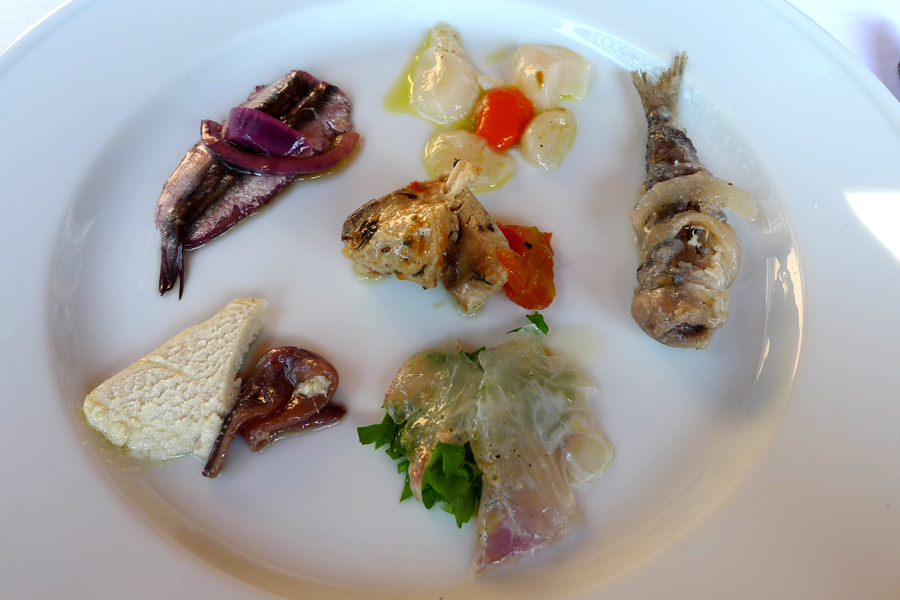
Seafood appetizers at Batelina.
TWO MORE GREAT MEALS
I alway say that I travel for the four-hour lunches, and I added two more to my mental scrapbook of unforgettable afternoon meals. Stancija Meneghetti in Bale and Konoba Batelina (Cimulje 25, Banjole; +385-52-573-767) in Banjole stand on opposite ends of the elaborate scale. Meneghetti, a rentable villa on a working vineyard and olive grove, is where you'd want to bring a group of friends for an elegant week in the country. Batelina is an unpretentious, family-run tavern that serves the impossibly fresh fish caught by Danilo Skoko, the father, whose favorite fishing season is autumn, for sole and orata.
Batelina is somewhat famous because the chef son, David, competed on Master Chef Croatia and featured prominently in Anthony Bourdain's No Rervations episode about Croatia. David is what you'd expect a tough and talented fisherman/chef to look like: burly and bearded, with a soft core. He has several big tattoos: an octopus spreads across his right arm and chest; his sisters occupy the other side of his body his younger sister's face is on his chest, his older sister is in a bikini on his back. I know, I know, but it totally works.
Asked about the family's cooking style, David explains, "We cook what we have. And we present it in the best way we know." Mom Alda is a former men's tailor who only began cooking thirteen years ago. She serves what she used to feed her family. Asked if clients appreciate her cooking more than her in-laws and nephews did, she replies, "well, yes." Obviously.
The family is known for using every part of the fish, a nose-to-fin approach, if you will. They are only open for dinner, but they make an exception for our lunch. We sit at a picnic table under an awning on the porch, drinking Trapan rose and malvasia. (At this point in my trip, I have lost track of how many gallons of malvasia I have consumed.)
The appetizers stream out in endless succession: anchovies with conger eel mousse, sardines in saor, sea bream carpaccio, shark belly confit, anglerfish liver mousse on onion marmalade. I assemble a plate with one bite of each, and everything is pretty intense. Anglerfish tripe is a little too chewy and jellyfishlike for my tastes, but bonito confit is meaty and terrific.
The main courses include minestrone with scallops the size of garbanzo beans, red mullet with grilled polenta, and fried sardines. I'm in my seafood happy place.

Actually, time stands still at Meneghetti.

A bedroom in the villa.
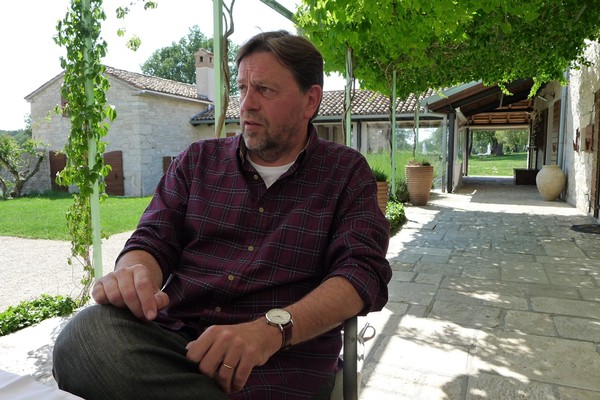
Goran Hanžek at lunch at Meneghetti.
Stancija Meneghetti was supposed to be a retirement project for the partners, long-time friends who had successful careers and were ready to mellow out. Goran Hanžek, my host for lunch, used to run the biggest wine company in Croatia; his partner Miroslav Plišo was a lawyer. They bought this parcel of land intending to use it as a private country retreat for their families, but it grew, and by 2007 theirs was named the world's best olive oil. Now the stancija ("farm") produces some 1,500 liters of olive oil per year, sold exclusively in speciality shops around the world. After a few years, they added wines: two sparkling wines; three whites made from blends of chardonnay, pinot blanc, and malvasia; and three red made with merlot, cabernet sauvignon, cabernet franc, and refosco.
The beautiful, three-story villa is available for rent and can accommodate parties are large as ten for about €10,000 per week. A couple for one night will spend about €150. A crazy bargain for this kind of countryside luxury.
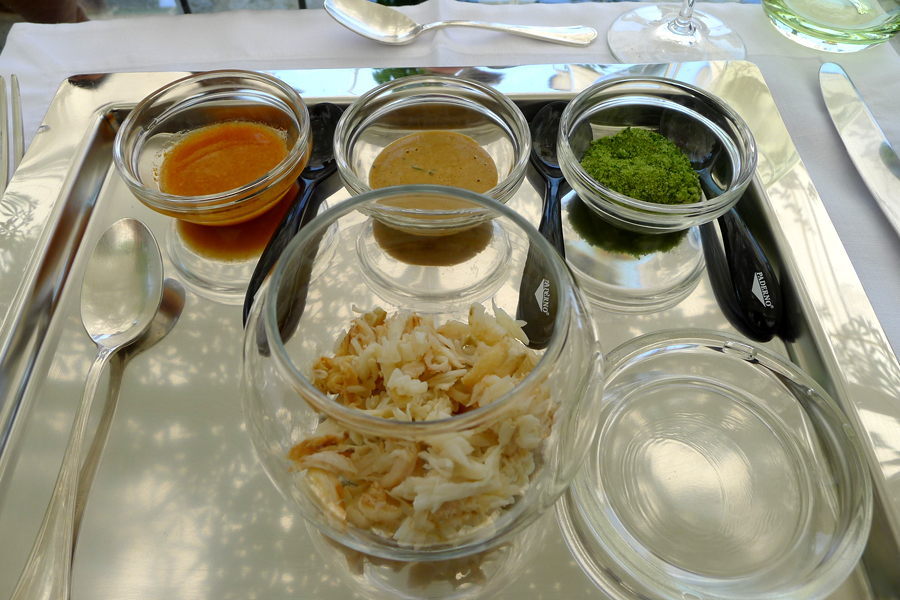
Crab appetizer at Meneghetti.

Layers of dessert.
The food, I wasn't surprised to see, is exceptional, a feast for palate and eyes. A crab appetizer was served in jars with sauces and herb powder for DIY assembly. Mussels soup was served with cold tomato foam in a martini glass. Sea bass was prepared with black truffles, polenta, and herbs. (I stole several branches of rosemary with Goran's blessing. I've been cooking with it since.) Dessert was a fantastic layered coupe of, from top to bottom, chocolate cream, walnut ice cream, their own rosulja olive oil, and Maldon salt. Friends, this is a recipe worth stealing.

Tito's Brijuni ride: A badass Cadillac.

Tito's Brijuni pet: A badass zebra.
PARKS OF EXTREME AWESOMENESS
Oh Tito. Tito, Tito, Tito. I won't say much about your tenure as the authoritarian president of Yugoslavia and General Secretary of the League of Communists of Yugoslavia, nor about your human rights abuses, your many wives, your collection of foreign leader pals from the first, second, and third worlds. But I will say that you built Brijuni into one dazzling pleasure retreat on a few tiny islands off the coast from Fažana.
You take the ferry, along with about a zillion screaming Croatian school kids, and embark at the port in front of two classic mid-Century hotels that are in the process of being restored, though hopefully not moderninzed too much, because the frozen-in-time aspect is intoxicating. If you're very smart, you have arranged for Slavica Vrekalic from the local tourist office to be your guide. She's a sly and spunky woman of an uncertain age with a wicked sense of humor. Then you hop on a golf cart and cruise around the main island to see its many wonders. Dinosaurs, zebras, an elephant called Lanka, an ancient olive tree, Roman ruins, Byzantine fortresses. If this isn't the greatest national park ever, I don't know what is.
Acutally, it might be Kamenjak Nature Park in Premantura at the southernmost tip of Istria. It's a wild expanse of rocky coves and inlets, where people in small and large groups stretch out in the sun to dive off cliffs into clear waters, windsurf, snorkel, drink, picnic, dock a yacht, kiss, sunbathe, and do the things people do when the day's agenda involves nothing more than sea, sun, and an endless horizon.
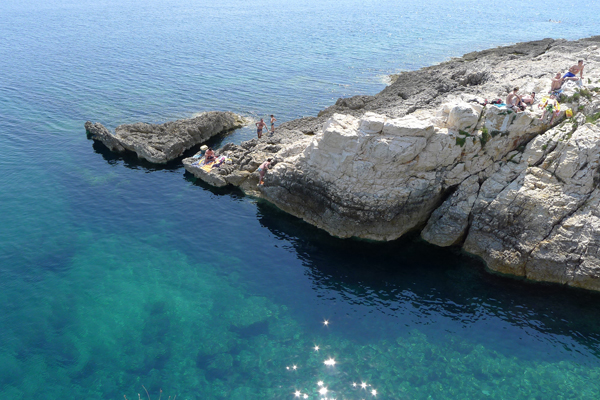

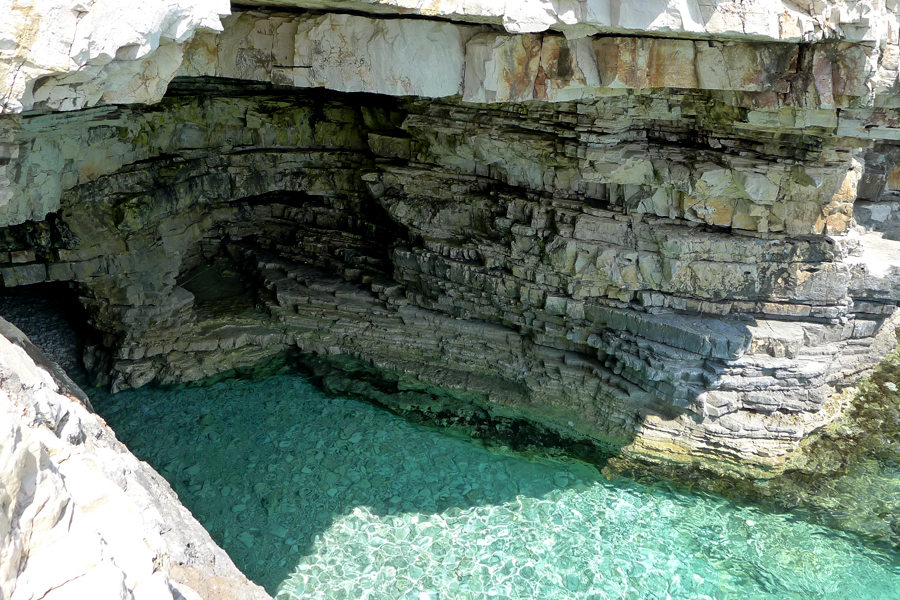

Scenes around Kamenjak Nature Park. You can see Porer, the lighthouse, on the horizon in the photo above.
The eight-year-old boy in everyone will also be tickled by Kamenjak for so many reasons, starting with the fact that it's known as dinosaur island because of the 150 footprints that have been discovered. And for the Stonehenge-like monoliths. And for Porer, the lighthouse that you can rent. And for Kolombarica, the Cove of the Doves that you can swim around in. If you're incredibly lucky, you might spot the monk seals who live in the cove. They're being watched by scientists at the Blue World Institute of Croatia: A solar-powered camera sends them an SMS when the seal enters the cove. Awesome. If you want to camp overnight, you can't, but there are campsites right outside, and I won't tell anyone if you sneak in after dark.
Just don't stay in Medulin, the small town outside Kamenjak. It's overdeveloped and filled with package tour groups.
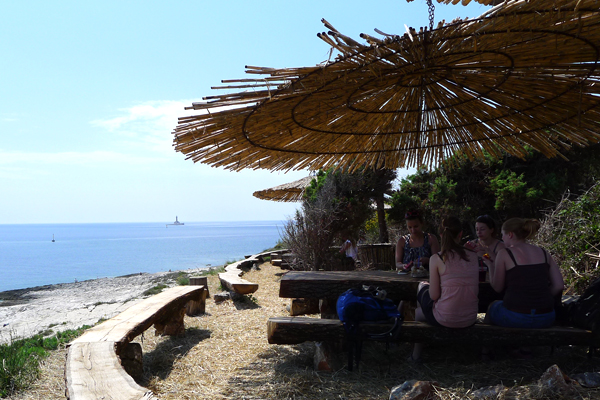
Safari Bar.
There are five bars along the coves in the park, but since licenses rarely extend more than one year, operators don't bother making much of them. The exception is Safari Bar, a kooky snack bar/restaurant with swing sets, sliding boards, picnic tables made of logs and umbrellas made of bamboo. It's owned by Vlado. He's in his late 60s; his wife is in her late 30s. They have two daughters and live in the park in a mud hut in the ground.
Cars are only allowed up to a certain point, so bring a bike or be prepared to walk. The farther into the park you walk, the more desolate it gets and the fewer people you'll see. This is what you want: to be as alone as possible, with just your beach blanket and your pals daring you to jump off the cliff into the Adriatic. (Call me chicken: I didn't. Sure wish I had.)
But maybe that was my plan: Leave a little something on the table, so there's plenty to come back for.
PLAN YOUR TRIP
Fly: There are no major airports in Istria. in I flew to Venice (VCE) and drove a few hours into Istria. The other way to fly is into Zagreb (ZAG), and then drive to Istria. Both are lovely drives through hilly, green countryside.
Car: You'll want a car to get around, but mostly you'll want your own car so you can stop where it's beautiful for a swim, a picnic, or a walk.
WHEN TO GO
If you want to swim, go in the summer months from July through September. Otherwise, it's beautiful year-round, especially spring through autumn.
MAP IT
See all the locations in this story. (Google Maps)
